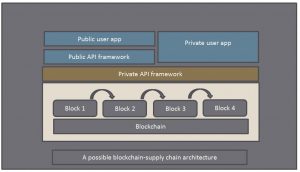Reimagining blockchain for the supply chain
What is blockchain? And why has blockchain with the supply chain created huge expectations in the industry circles? First, blockchain is a glorified ledger which cannot be hacked to alter any transactions that have happened in the blockchain network. All the nodes in the blockchain know about all the transactions that have happened since the network started. Hence, to compromise a transaction, all the nodes or the majority of the nodes have to be compromised in a reasonable amount of time, which is not practically possible. Blockchain was proposed as a platform on which cryptocurrencies can be generated and distributed, and bitcoin was the first currency to use blockchain. Slowly, people started realizing that blockchain technology can be used for other use cases where a distributed trust or trustless network is needed. For example, contracts can be made smart by using blockchain to register and maintain them. Any change in contract can be tracked and the sanctity of the contract will be secure. The same goes for the supply chain, where orders placed on blockchain can be tracked from start through delivery.
Power of blockchain
Blockchain technology is all about tracking a transaction from the start until the end, and all the nodes in the network register and update themselves with the status of transactions. The power of blockchain comes from the fact that there is no central authority to maintain the record of transactions; the blockchain is distributed and therefore trust is also distributed and not negotiable. All transactions are shared among participating nodes, and any node that gets compromised can be easily isolated since for any transaction to pass muster, the majority of nodes should agree about the said transaction. This feature of blockchain is the key to its strength and can be adopted to variety of use cases. One such use case/domain where blockchain can be adopted is the supply chain, where orders are placed, tracked, delivered, invoiced, returned and so forth.
Blockchain in the supply chain
A supply chain is a business where orders and the fulfilment of orders and delivery of items are all meshed together in a gigantic mesh or, to some, a gigantic mess. Each customer who orders an item and the supplier who supplies them do not see eye to eye for most of the transaction’s phases. The customer who has ordered a certain item might have ordered the item for somebody else who happens to be his customer. The end customer will not have any visibility of his orders unless the first customer updates his system, provided he has a system, with the data from the previous system through which he has ordered items. Cumbersome is the kindest word here.
In short, it can be termed that any supply chain’s digital infrastructure is opaque to anybody except for a few who are direct consumers or producers. The reason for this opaqueness is trust — or lack of it. Except for entities that place orders to the entities that produce the ordered items, the systems are designed to exclude everybody else for the sake of security. It can go along like this, keeping all the other stakeholders guessing.
What if a producer would like to know how much his customer has of his merchandise in stock and predict when his customer will place orders?
What if a producer knows the rate of consumption of his product by a set of his customers, so that he can plan his production accordingly?
Just-in-time production anyone?
At present, these scenarios are heavily dependent on the customer willfully sharing details about his inventory or order history for anybody to see for them to plan accordingly, which is unlikely, for the very reason of security.
What is the answer to one of such many conundrums? Blockchain?
Now, imagine that a customer places an order on a system that has blockchain as underlying platform. In other words, the blockchain is the thing that registers all the transactions, including ones the customer has placed. The producer to whom the order has been placed will see the order and will start servicing the order. If said customer has another customer on behalf of whom the order was placed, the blockchain will enable the other customer to see the status of the order as well. The blockchain enables this kind of transparency since the underlying data of the blockchain is not hackable by any normal means — it would take enormous computing power and time to do any damage to data.
How blockchain can be used in the supply chain
The supply chain with blockchain can be called “supply chain platform with blockchain,” or SCBC. The blockchain has to be the underlying infrastructure for all the data flowing through a supply chain infrastructure. This data needs to be in the form of chunks of individual data that can be compartmentalized easily, such as an order, invoice and so forth. The compartmentalization can help preserve the continuity of the data into next morphing if needed. The SCBC should have a public interface where the interested entities can gain entry with proper credentials. These credentials can be issued in such a way as to enable the entities to see data pertaining only to their interests, and they cannot peek into other entities’ data.
 How can access to the underlying data in a blockchain be given? One way — and the most popular — is to use APIs. If the APIs are standardized, any entity that would like to look into the data and act upon it will be able to do so without any hassle. These APIs would be part of any blockchain-based supply chain platform and will allow applications to be developed for which the imagination is the only limit. The use case explained above — an entity performing prediction of his own manufacturing based on his customers’ consumption patterns for the last orders — will be a reality.
How can access to the underlying data in a blockchain be given? One way — and the most popular — is to use APIs. If the APIs are standardized, any entity that would like to look into the data and act upon it will be able to do so without any hassle. These APIs would be part of any blockchain-based supply chain platform and will allow applications to be developed for which the imagination is the only limit. The use case explained above — an entity performing prediction of his own manufacturing based on his customers’ consumption patterns for the last orders — will be a reality.
In another scenario, an end user of a product can track the inputs of the product he bought. This might be of interest to consumers who are more interested in knowing that they are buying products that are manufactured in an ethical and environmentally friendly manner. This kind of consumer is on the rise, and blockchain will enable these consumers to be aware of their purchasing choices. While it is true that manufacturers themselves certify their products are manufactured in an environmentally friendly manner, there is no transparency in such a declaration and the end user has to take the manufacturer’s word with full trust, which is a difficult proposition.
Conclusion
Even though blockchain was first envisaged for creating, distributing and maintaining cryptocurrencies, lots of other uses are imagined on a daily basis. Use of blockchain in the supply chain is one of them, and will be adopted more or less in due course of time; the benefits outweigh the pitfalls.
All IoT Agenda network contributors are responsible for the content and accuracy of their posts. Opinions are of the writers and do not necessarily convey the thoughts of IoT Agenda.
